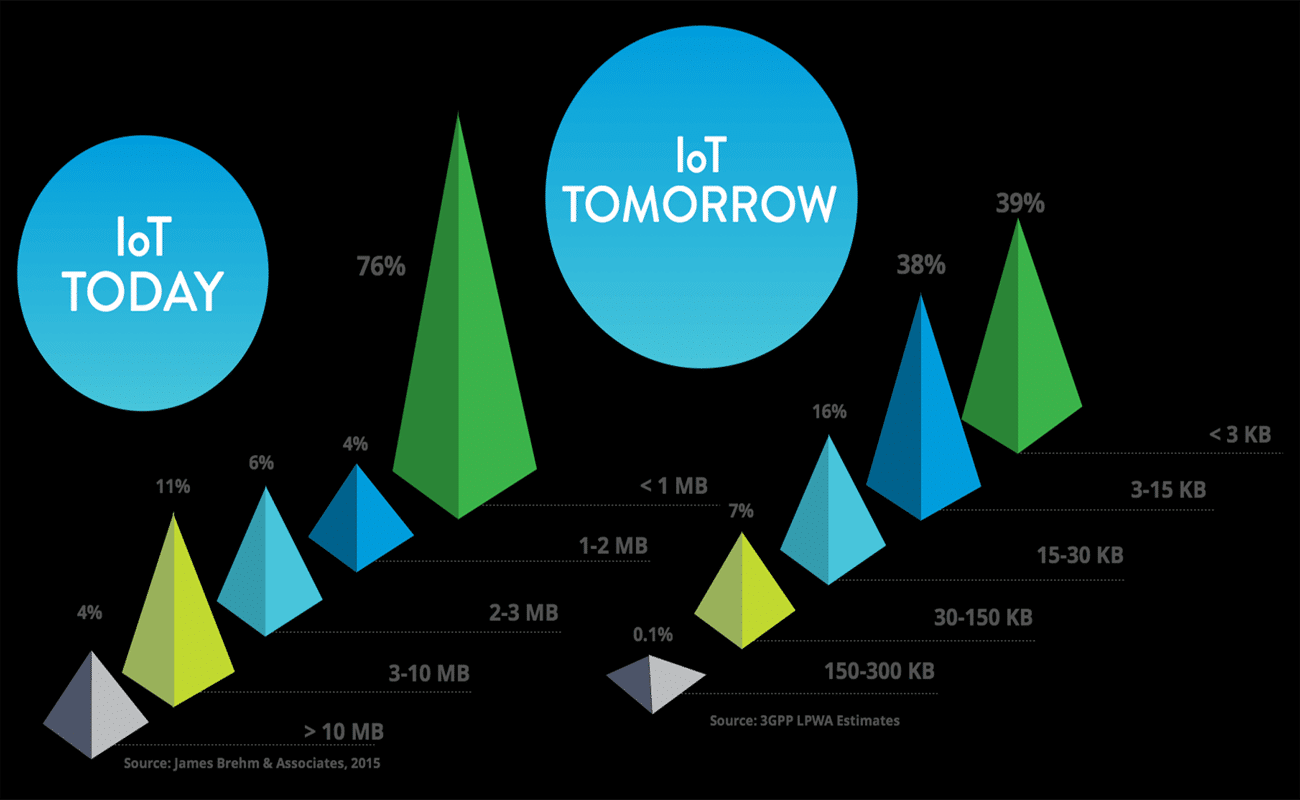
LPWA is Powering Enterprise IoT
Low Power Wide Area (LPWA) wireless products are rapidly becoming a key requirement for enterprise Internet of Things (IoT) applications. Unlike consumer IoT products such as thermostats, security systems, fitness products, etc., the scale of enterprise IoT deployments is far larger than commodity wireless technologies—Wi-Fi, RFID, Bluetooth Low Energy (BLE), Zigbee—can cost effectively support.
LPWA is excellent for connecting 100s or 1,000s of devices that need to send small amounts of data over a long range, while conserving battery life and minimizing costs. Many enterprise IoT applications need to transmit only a small amount of information—for example, an inventory tracker in a car that transmits location data when a car moves around and between an auto dealership’s lots, or exits and re-enters the area during a test drive. The low power requirements of such a device allow tasks to be done with minimal cost and battery drain.
What Makes LPWA a Perfect Fit?
LPWA defines wireless networks for IoT devices characterized by low power consumption and long-range capabilities, making LPWA ideal for enterprise IoT applications.
- LPWA saves on power: Low power is one of the primary differentiators of LPWA. It’s easy to transmit data long distances if devices are connected to a power source. LPWA sensors on devices being monitored, however, can be left alone inside a building, outdoor locations, and other difficult-to-access areas for very long periods of time—years in most cases—without battery swaps. This is in stark contrast to the power-hungry nature of cellular Machine-to-Machine (M2M) devices.
- LPWA operates over a wide area: Anyone who has used Wi-Fi, RFID, BLE or Zigbee knows how important it is for devices to be located close to an access point or reader. Instead of requiring dozens of access points or readers, LPWA devices are designed for long range, point-to-point communications where a single gateway can cover a large outdoor or indoor area that is owned or operated by an enterprise user.
What are the Benefits of LPWA?
LPWA is cheaper to deploy and operate than other wireless options. The cost benefits can be broken down into infrastructure, communications, and devices.
- Light infrastructure makes LPWA acquisition affordable: Although LPWA is wide-area, it requires far less infrastructure than Wi-Fi or BLE networks. A typical enterprise LPWA implementation requires only one or two gateways, reducing the costs of deployment, maintenance and operations. LPWA’s cost per square mile of coverage is far lower than any other wireless technology.
- Unlicensed spectrum bands make LPWA operations cost-effective: Radio frequency spectrum is divided into licensed and unlicensed bands. Licensed spectrum is very expensive; Mobile Network Operators (MNOs) spend billions annually on licensed spectrum and then pass this cost on to users. For IoT applications like automotive telematics, MNOs and licensed spectrum are the only option when continuous mobile coverage is required.Unlicensed bands are free to use without limitation, provided devices comply with applicable regulations, like FCC Part 15 in the U.S. This is why BLE and WiFi are ubiquitous. Unlicensed spectrum is not appropriate for public networks covering cities states due to potential interference, but it’s ideal to cover tens of square miles in and around enterprise owned buildings and campuses.
- Low-cost devices make LPWA scalable: The primary components of IoT devices are sensors, radios and batteries. Sensors can monitor location, temperature, vibration, humidity and more. The ubiquity of smart phones has driven the cost of most sensors down to well under a dollar. Radios are the key to both the range, cost and battery life of devices. By combining intelligent signal processing with commodity radio components, costs of devices can be driven down to just a few dollars in high volume. Cellular devices required to operate over an MNO’s infrastructure, however, are far more costly.
Conclusion
Companies using LPWA for enterprise IoT vs. other wireless technologies benefit from fast deployments, low operating costs and low device costs.
Low power wide area networks will continue to revolutionize the way companies do business by allowing them to collect data in ways that until recently were cost prohibitive. As LPWA evolves we are certain that it will continue to help businesses lower operating costs, improve customer relationships, and operate smarter.
RadioTrax
RadioTrax—the complete IoT Inventory management solution from Cognosos—is the smarter more productive way to run your company. By connecting your inventory and providing real-time movements, RadioTrax empowers your team with the tools to provide seamless customer experiences, increase sales, and optimize operations.


